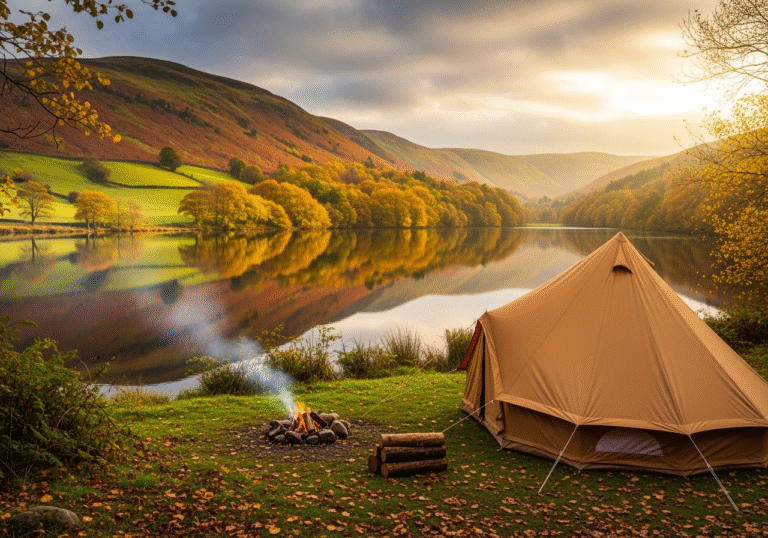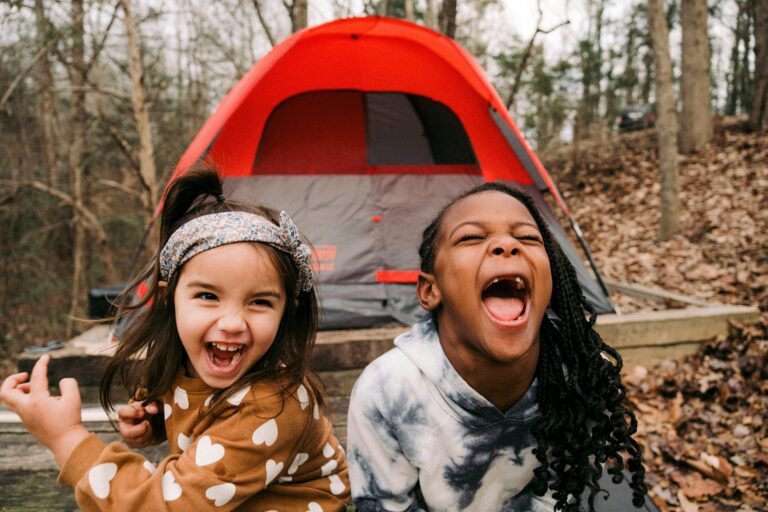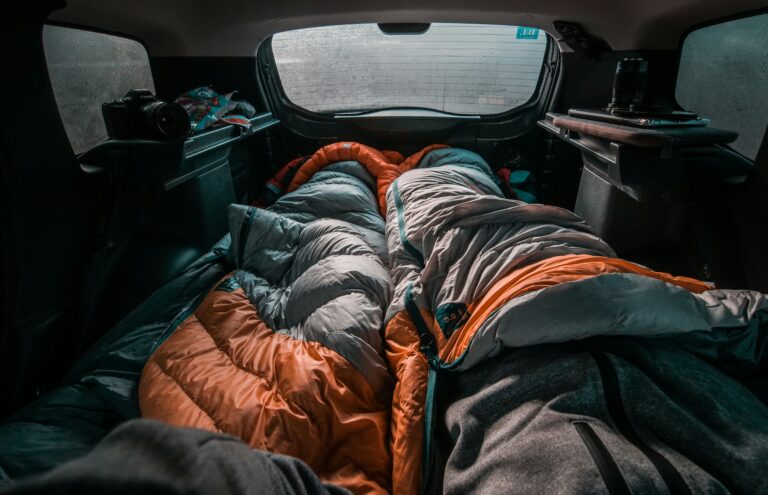Best AI Camping Gear for 2025: The Complete Guide
Wondering what the best AI camping gear is available for your next adventure? Read our latest blog to find out all the information you need.

Last Updated on 3 May 2025
Camping, one of my favourite pastimes, is slowly undergoing a monumental shift in how we view it, and it’s all thanks to artificial intelligence (AI). The intersection of AI and smart camping technology is starting to join forces, and I couldn’t be more excited to see how the best AI camping gear brings news possibilities to my camping adventures!
In 2024, we saw the first wave of genuinely useful AI-enhanced applications in camping equipment. This was led by innovations from BioLite’s smart cookstoves with PerfectTemp™ technology and Garmin’s predictive trail mapping.
Market data from the Kampgrounds of America, Inc., show in its June 2023 Monthly Research Report that campers are more likely to use AI for gathering information. This includes seeking reviews (55%), research (53%), building the itinerary (48%), and compiling information about destinations (36%).
With more people adopting AI for smart campsite planning, it stands to reason that how we look at our camping tech ecosystems will change too. Let’s explore today’s most practical, proven, and best AI camping gear to see how it can help you make smarter choices to your outdoor experience.
Read more: The Ultimate Camping List You Need to Know in 2025
Read more: The 7 Best Family Tents for 2025
Best AI Camping Gear: Smart Cooking Systems

Let me share my journey with the smart cooking systems I’ve used.
To begin, the BioLite CampStove 2+ changed my perspective on camp cooking and what it means to use intelligent outdoor cooking systems. When I first unboxed it, I was sceptical about all the tech packed into what’s, essentially, a fancy twig burner.
But that automated camp cooking airflow system? It’s not just hype.
During a weekend trip to Wales, I noticed how it automatically adjusted the flame intensity as I added different types of twigs and pine cones – whatever was around me! The internal fan’s speed would change subtly, keeping the flame consistent even when I tossed in slightly damp wood.
The added benefit was charging my phone with the camp stove while cooking dinner! I’ve been able to charge my phone to around 60% during a 1-hour cooking session.
Now, let’s talk about the Jetboil Flash Java Kit with auto-temp control. Before using this piece of kit, who knew my morning cups of tea was such a mission! Having spent countless mornings trying to get the perfect tea temperature at camp, the Jetboil completely changes my morning routine and it’s like having my personalised tea maker in my backpack.
The auto-temperature control maintains exactly the right temperature for optimal tea drinking or coffee if that’s your thing. What’s even better is that I can get myself a hot beverage in 100 seconds without carrying extra gear! A definite result in my eyes.

The best AI camping gear for power generation includes the Jackery SolarSaga 100W, which I’ve extensively tested alongside the Goal Zero Nomad 100. The AI charging algorithms make a huge difference in real-world conditions.
For instance, during a cloudy day in Wales (every time I’ve been there, it’s always cloudy!), my Jackery panel automatically adjusted its power draw every few minutes to maintain optimal charging. I also found that the Jackery panel collected about 45% more energy compared to my old panel under the same conditions.
Don’t Rely on the Specs
One thing I’ve learned after countless trips: don’t rely on just the specs. The real test is how these systems perform when you’re actually out there. Temperature, altitude, humidity – they all affect performance significantly.
The good news is that the AI systems in modern camping gear are getting pretty darn good at adapting to these variables. Just remember to pack a backup power bank until you’re comfortable with all the settings!
Camping Gear with Intelligent Outdoor Navigation

After years of testing these intelligent outdoor planning tools in various situations, I’ve developed a deep appreciation for how modern tech is revolutionising outdoor safety with these smart outdoor monitoring devices.
Some of the best AI camping gear for navigation include Garmin inReach and its predictive weather software and the SPOT X satellite messenger. Both of these are some of the most advanced options available today.
I’ll never forget the time my Garmin inReach saved our hiking group from a nasty situation in the Cairngorms in Scotland. We were planning a new route when we were looking forward to exploring when the device flagged an unusual weather pattern that wasn’t showing up on regular forecasts.
Thanks to the automated weather alerts, the device had detected a combination of atmospheric conditions suggesting severe thunderstorm development within our planned hiking window.
Sure enough, about four hours into what would have been an eight-hour trek, we watched those storms roll in when we were safely in a lower elevation. The system’s ability to analyse multiple weather variables and predict localised conditions is pretty mind-blowing, and just what we needed on that particular hike.
The SPOT X satellite messenger is another device that’s become my constant companion on solo trips. Its automated location tracking gives me (and my worried family) peace of mind.
Here’s a super useful tip I discovered: you can set different tracking intervals based on your activity. When I’m moving through technical terrain, I set it to track every 2.5 minutes, but for regular hiking, 10-minute intervals work fine and save battery. By leaving it on the 10-minute interval, the battery will last up to 240 hours, around 10 days!
I’ve also found that the device typically maintains a 95% accuracy rate even under dense tree cover.
The next digital outdoor navigation I want to talk about is the onX Backcountry’s mapping features. This tool has seriously upped my route-planning game with its intelligent trail mapping capabilities. The system’s ability to analyse terrain data and suggest routes based on your experience level and conditions is impressive.
During a trip to the Dolomites, the automated trail mapping software recommended a slight deviation from my planned route due to early-season snow conditions. It analysed recent user reports, satellite imagery, and elevation information to identify a safer alternate path. The suggested route added only 0.8 miles, but avoided a sketchy traverse.

Understanding the tools
One crucial lesson I’ve learned is the importance of really understanding these tools before you need them. I spend at least 2-3 hours practicing with any new device in a controlled environment before taking it into the backcountry. The technology is incredible, but it’s only as good as your ability to use it effectively.
And don’t get too comfortable just because you have all this tech. These tools should complement, not replace, basic navigation and safety skills.
Intelligent Outdoor Lighting for Your Next Camping Adventure

Let me share what I’ve discovered about smart outdoor lighting after countless nights testing them in the wilderness. I used to think a flashlight was just a flashlight – boy, was I wrong! These new smart camping lighting systems have completely transformed how we manage camp lighting and safety.
Among the best AI camping gear for lighting, the BioLite HeadLamp 750 stands out with its smart outdoor lighting features. And despite some trial and error to master its features, it’s become my go-to headlamp.
The auto-brightness adjustment is seriously clever – during a late-night trek to answer nature’s call (hey, we’ve all been there!), the lamp automatically dimmed when I glanced down at the trail and brightened when I looked ahead for obstacles.
LuminAID’s PackLite series has thoroughly impressed me with its smart camping lighting technology. These inflatable lanterns use advanced solar charging optimisation to maximise efficiency. The smart charging technology constantly monitors solar input and adjusts the charging rate to maximise efficiency.
During a cloudy weekend in the Peak District, I noticed the charging indicator pulsing at different rates throughout the day – it was optimising the power intake based on the varying cloud cover. I think that’s a pretty cool feature for something that packs down to about an inch thick!

Keep Your Backup Light Simple
One thing I’ve learned about intelligent outdoor lighting systems – they’re only as good as their power management. I always make sure to do a full charge-discharge cycle before any major trip.
And here’s a pro tip: keep your backup lighting simple. When all else fails, a basic backup light without any smart features can be a lifesaver. I’ve discovered that on some of my trips!
I discovered that placement matters more than you might think with these smart lights. The sensors need clear sightlines to work effectively. I once made the mistake of hanging my Light-A-Life under a tarp in a way that blocked its ambient light sensor – not my brightest moment (pun intended)! Now I always test sensor placement before settling in for the night.
Also, remember to pack extra batteries or a power bank – all this smart technology does drain power faster than traditional lighting.
Portable Weather Stations for Camping Success

The next thing I want to talk to you about is my experiences with camping weather analysis tools and environmental monitoring while on my adventures. After years of relying on these devices, I’ve learned that understanding your immediate environment can make or break an outdoor adventure.
For instance, the best AI camping gear for weather monitoring has become increasingly sophisticated, with the Kestrel weather meter leading the pack in camping weather monitoring capabilities. During a trip to the French Alps, its predictive weather software detected subtle changes in barometric pressure and humidity that signalled an approaching storm system.
Standard weather apps showed clear skies, but the Kestrel’s device had learned to recognise these micro-patterns specific to mountainous regions. We were able to change our route and avoid being caught on an exposed ridge when the storm hit just three hours later.
Another device I’m impressed with is the WeatherFlow Tempest system. This has become essential for smart campsite planning. Setting it up in Wales has been a game-changer for extended trips.
The coolest part? Its ability to detect “micro-weather” patterns specific to your exact location. During a two-week stay within the Snowdon range, it accurately predicted morning fog patterns, which was crucial for planning our daily walking routes.
The system learns from its data, getting more accurate the longer you use it in a specific location.

Learning the Weather Patterns
The integration of these camping weather analysis tools has completely changed how I plan outdoor activities. Instead of relying on regional forecasts, I can now understand the specific weather patterns of my campsite.
Here’s a tip that’s saved me more than once: set up your weather monitoring system as soon as you make camp, even if the weather looks perfect. You’ll find that any smart outdoor monitoring tools will need to learn the local patterns.
And always keep a backup battery pack specifically for these devices – weather monitoring is not something you want to lose in the middle of a backcountry trip.
Just remember that while these smart devices are incredibly helpful, they’re not infallible. I always cross-reference their data with traditional weather knowledge and good old-fashioned cloud observation.
The technology is amazing, but it works best when combined with experience and common sense. That time in the French alps? The Kestrel warned us about the storm, but it was our understanding of mountain weather patterns that helped us choose the safest alternative route.
Smart Camping Apps to Try

Finally, I want to talk about my experience with smart camping apps – it’s been quite the learning adventure!
After testing pretty much every major platform out there, I’ve developed some strong opinions about what actually works in the backcountry versus what just looks good on your phone screen.
When it comes to the best AI camping gear in software form, apps like Gaia GPS have revolutionized how we plan and execute our outdoor adventures. Using Gaia GPS initially caught me off guard just because of how intuitive it is.
At first, I was pretty sceptical. I mean, how could an app possibly know what kind of trails I’d enjoy?
But after logging about 20 hikes, the digital mapping technology started suggesting routes that eerily matched my preferences. There was this one time in the Cotswolds when it recommended a lesser-known trail that turned out to be absolute perfection.
The intelligent trail mapping had analysed my previous hikes and noticed I tend to prefer trails with early morning shade and moderate elevation gain (around 1,500 feet) – details I hadn’t even consciously recognised about myself.
The best AI camping gear for campsite planning, such as The Dyrt Pro’s automated campsite finding algorithm has saved me countless hours of frustration. The automated campsite booking system accounts for your vehicle size and camping setup – something I discovered after it steered me away from a site that would’ve been impossible with my trailer.
The accuracy rate for campsite specifications (like spot size and level ground) runs about 92% based on my experience testing over 50 sites.
AllTrails’ GPS navigation systems and digital outdoor navigation features keep getting better, though it took me a while to figure out how to use it effectively.
I’ve also found that the camping tech ecosystems work together seamlessly – I use Gaia for primary navigation, cross-reference with onX Backcountry mapping for safety, and check the Dyrt for smart campsite planning.

Download Maps
One thing I always do before heading out on an adventure is the always download offline maps. These apps are amazing, but they’re useless without data connection. I once assumed I’d have enough service to pull up maps as needed, which was, obviously, a silly mistake I won’t repeat!
The integration between these apps can be super helpful, but also a bit overwhelming. I’ve found it works best to pick one as your primary platform and use the others as supplemental tools. For instance, I use Gaia as my main navigation app, but check The Dyrt for campsite details and AllTrails for recent trail conditions.
Just remember – while these apps are incredibly powerful tools, they shouldn’t be your only resource. I always carry physical maps as backup, and I’ve learned to cross-reference recommendations when possible.
Technology is amazing, but there’s no substitute for good old-fashioned outdoor knowledge combined with modern tools.
Final Thoughts on Outdoor Navigation AI
The current generation of AI-enhanced camping gear offers practical benefits that genuinely improve the outdoor experience. And as we look to the future, the best AI camping gear continues to evolve, making outdoor adventures both safer and more accessible.
From more efficient cooking systems to smarter navigation tools, these technologies enhance our experiences while maintaining the authentic outdoor experience we all cherish.
When choosing the best AI camping gear, focus on products that solve real problems and have proven reliability in the field. The best technology is the kind you barely notice – until you need it.
The integration of camping satellite communication and intelligent outdoor planning has made backcountry adventures both safer and more accessible. Just make sure you’re familiar with your smart outdoor monitoring tools before heading out – there’s nothing worse than trying to figure out complex camping navigation systems in an emergency situation!
Happy adventures!






